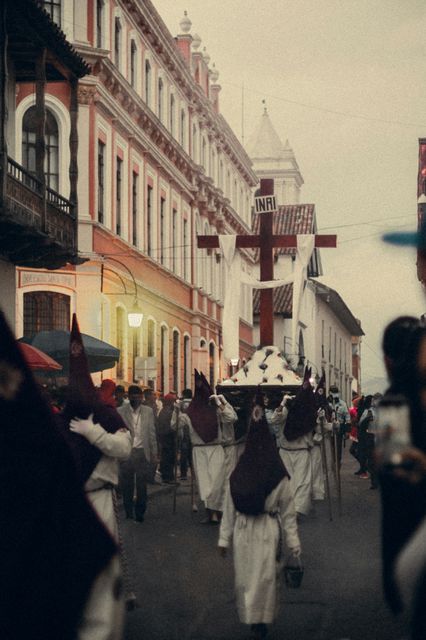
During Holy Week, more than any other time of the year, followers of Christ go beyond reading about the events of the Gospels to bringing them to life with reenactments. There is the procession of palms on Palm Sunday. Many churches reenact Jesus’ washing of feet and the Passover meal that became Communion. There is the liturgical practices of stripping the altar and draping the cross with a black cloth. We don’t just hear the story. We see it, and perhaps feel it, in a deeply meaningful way.
Of course, It is tempting to reduce these reenactments to historical remembrances and celebrations. We enjoy the events of the day and find a way to celebrate them in worship. We feel the emotion of the moment and move on.
Take Palm Sunday, for example. Many churches often let children lead the procession of palms in worship. But there is no mention of children at all in the gospel narratives, so one might wonder why we, and not the children, aren’t waving these palm branches. Pick up any Bible and this scene is described as Jesus’ triumphal entry, and yet, Jesus seems to go out of his way to make it anything but triumphant.
What is going on here? Could it be that even without realizing it, we are attempting to put some boundaries around and give some structure to this story? And could we be doing this because we realize, at some level, that it is trying to challenge and evoke something deep within us?
The story of Jesus’ entry into the city is usually understood as a spontaneous celebration of Jesus’ followers. But many have suggested that this was an intentional act of provocation by Jesus. He could have walked through the gate into the city, just like everyone else. This time he chooses to enter on a colt. The securing of the colt by two of his disciples suggests that he had prearranged its use.
But it’s not just Palm Sunday that seems to have Jesus acting with intent and purpose. There is the confrontation in the Temple, where Jesus turns over the tables of the money changers and the merchants selling doves. He prevents anyone from carrying merchandise into the Temple courts. This event is often understood as a spontaneous expression of righteous anger, but again, it may be a symbolic and provocative act.

It was also a prophetic act. Jesus would know the stories of prophets who enacted their message with symbolic actions. Jeremiah makes a yoke and wears it to represent the coming bondage that Judah will suffer. Ezekiel shaves his beard and his head and divides it into three separate parts to represent three different fates of his people. Another time, well, he eats a scroll.
With his actions on Palm Sunday, Jesus is delivering a prophetic message, a word from God that he wants us to hear and to which he wants us to respond. But what is that message?
Entries into the city were a familiar occurrence to the early readers of scripture. Those familiar with the events of the Jewish revolt might think of the coup when the people welcomed Simon bar Giora, who then drove Eleazer and his faction from the Temple. Those who lived in Rome might have witnessed the triumphal procession of the emperor Vespasian in celebrating the defeat of the Jews. In fact, around the same of Jesus’ entry, there was another procession happening in Jerusalem. It was standard practice for Roman governors to be in Jerusalem for a major religious festival. They did so, not out of reverence for religious devotion of Jews, but to be there as show of force in case there was trouble.
Pilate’s imperial procession embodied the power, glory, and violence of the empire with its display of weapons and force. Pilate’s procession also embodied an imperial theology. The Roman Emperor, whom Pilate represented, was often called Son of God, Lord, Savior.
Jesus is making a deliberate contrast with his entry. There are no chariots and horses in full regalia. When Jesus rides in on a colt, he knows what he is doing. He would have known that Solomon, the greatest royal figure in Israel’s history, rode on a donkey the day he is recognized as king (1 Kings 1:33). He would have known the words of the prophet Zechariah that spoke of the king of Zion riding on “a colt, the foal of a donkey” (9:9).
The primary image that Jesus has used to proclaim his message is kingdom of God. With his actions on Palm Sunday and throughout the rest of Holy Week, Jesus sets up an intentional confrontation between his vision of the kingdom of God and other visions of how God could be in the world.

The people seem to get this with their cries of hosannas and blessings. This was the festival and Passover, and the pilgrims journeying to Jerusalem for the feast would be thinking of God as the one who liberates the people. The hopes for a renewal of society when God’s anointed king enters Zion and establishes true peace and justice shaped the desires of those with Jesus.
But how does this renewal of society happen? How is true peace and justice established? The events of Palm Sunday offer us two options.
Palm Sunday, and all the events of Holy Week, are about our particular understanding of God’s power and what it can accomplish.
Power is about the ability to get things done, to influence events. What you believe about power decides what gets done and how events are influenced. Most of us may think of power and coercive and forceful. Palm Sunday, and the events of Holy Week, declare that the greatest expression of God’s power is the humility of a man entering the city on a colt. The greatest expression of God’s power is the self-emptying of Jesus’ death.
This understanding of power confounds our expectations and turns our preconceptions upside down. Palm Sunday is more than an event in the life of Jesus to remember and recreate. We are invited to consider how we can expression this power in our own lives.
Two processions representing two different kinds of power? Which procession are we in? Which procession would we want to be in? Which procession, really, communicates our particular understanding of power and what power can accomplish?
